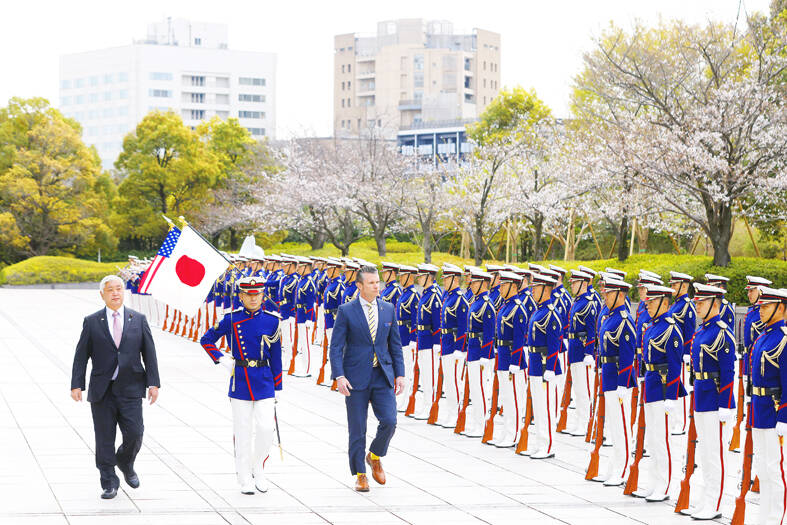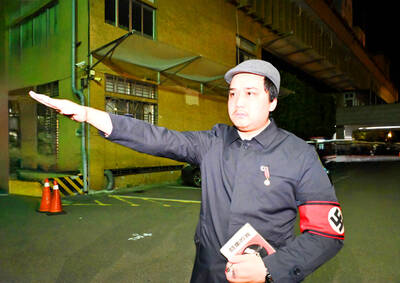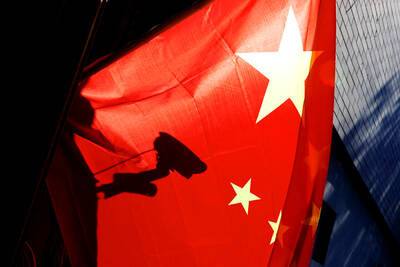The US will ensure “robust, ready and credible deterrence” across the Taiwan Strait, US Secretary of Defense Pete Hegseth said yesterday, calling China “aggressive and coercive.”
“America is committed to sustaining robust, ready and credible deterrence in the Indo-Pacific, including across the Taiwan Strait,” said Hegseth, who is in Asia on his first official visit and traveled to Japan from the Philippines.
Beijing has stepped up military pressure over the past few years around Taiwan, including near-daily air incursions, and has not ruled out using force to bring it under its control.

Photo: EPA-EFE
Hegseth added that Japan was indispensable in tackling Chinese aggression by helping Washington establish a “credible” deterrence in the region, including across the Taiwan Strait.
“We share a warrior ethos that defines our forces,” Hegseth told Japanese Minister of Defense Gen Nakatani at a meeting in Tokyo.
Calling Japan a “cornerstone of peace and security in the Indo-Pacific,” the Pentagon indicated that US President Donald Trump’s government would, like past administrations, continue to work closely with its key Asian ally.
Japan hosts about 50,000 US military personnel, squadrons of fighter squadrons and Washington’s only forward-deployed aircraft carrier strike group along a 3,000km archipelago that helps hem in Chinese military power.
Trump’s “America first” approach could mean weakening the US commitment for security in the region, analysts have warned.
However, Hegseth said the previous US administration had “created this vacuum, a perception that America was not strong and wasn’t prepared to deter conflicts from starting.”
“Our job now at this moment, here with our allies, is to say: We are re-establishing deterrence. Peace through strength, with America in the lead, is back,” he said.
He said Washington would “build an alliance so robust that both the reality and the perception of deterrence is real and ongoing, so that the communist Chinese don’t take the aggressive actions that some have contemplated they will.”
Hegseth hailed the “extraordinary strength of America’s alliance with Japan.”
“President Trump has also made it very clear, and we reiterate, we are going to put America first, but America first does not mean America alone,” he said. “America and Japan stand firmly together in the face of aggressive and coercive actions by the communist Chinese.”
There have also been expectations that, as he has done in Europe, Trump would press the US’ allies in Asia to increase military spending and to do more to ensure their own defence.
The Japanese government has also been reeling from Trump’s decision to impose a 25 percent tariff on auto imports from Thursday.
Hegseth said he “did not talk specific numbers” about defense spending in his talks with his Japanese counterpart.
“We’re confident that Japan will make the correct determination of what capabilities are needed inside our alliance to make sure we are standing shoulder to shoulder,” Hegseth said.
“They have been a model ally, and we have no doubt that will continue, but we also both recognize everybody needs to do more,” he said.
Nakatani said he told Hegseth that spending should be “implemented based on Japan’s own judgement and responsibility.”
“I also explained Japan has continuously been working on a drastic strengthening of our defense capability ... on which we received understanding from the US side,” he said.
Japan has been shedding its strict pacifist stance, moving to obtain “counterstrike” capabilities and doubling military spending to the NATO standard of 2 percent of GDP.
Former US president Joe Biden and former Japanese prime minister Fumio Kishida announced a “new era” in cooperation at a summit at the White House last year.
That included the creation of a new Japan-based US headquarters, which would take over operational oversight of US forces in Japan from the US Indo-Pacific Command in Hawaii.
It would serve as a counterpart to Japan’s new Joint Operations Command for all its armed forces, making the two countries’ militaries more nimble in case of a crisis over Taiwan or the Korean peninsula.
“We will accelerate our efforts to improve inter-operability and conduct effective bilaterally joint activities across the spectrum from peacetime to contingency,” Nakatani said.
“Expansion of the Japan-US presence in [Japan’s] southwestern region is one of our alliance’s top priorities,” he said.
Additional reporting by Reuters

SECURITY: As China is ‘reshaping’ Hong Kong’s population, Taiwan must raise the eligibility threshold for applications from Hong Kongers, Chiu Chui-cheng said When Hong Kong and Macau citizens apply for residency in Taiwan, it would be under a new category that includes a “national security observation period,” Mainland Affairs Council (MAC) Minister Chiu Chui-cheng (邱垂正) said yesterday. President William Lai (賴清德) on March 13 announced 17 strategies to counter China’s aggression toward Taiwan, including incorporating national security considerations into the review process for residency applications from Hong Kong and Macau citizens. The situation in Hong Kong is constantly changing, Chiu said to media yesterday on the sidelines of the Taipei Technology Run hosted by the Taipei Neihu Technology Park Development Association. With

A US Marine Corps regiment equipped with Naval Strike Missiles (NSM) is set to participate in the upcoming Balikatan 25 exercise in the Luzon Strait, marking the system’s first-ever deployment in the Philippines. US and Philippine officials have separately confirmed that the Navy Marine Expeditionary Ship Interdiction System (NMESIS) — the mobile launch platform for the Naval Strike Missile — would take part in the joint exercise. The missiles are being deployed to “a strategic first island chain chokepoint” in the waters between Taiwan proper and the Philippines, US-based Naval News reported. “The Luzon Strait and Bashi Channel represent a critical access

‘FORM OF PROTEST’: The German Institute Taipei said it was ‘shocked’ to see Nazi symbolism used in connection with political aims as it condemned the incident Sung Chien-liang (宋建樑), who led efforts to recall Democratic Progressive Party (DPP) Legislator Lee Kun-cheng (李坤城), was released on bail of NT$80,000 yesterday amid an outcry over a Nazi armband he wore to questioning the night before. Sung arrived at the New Taipei City District Prosecutors’ Office for questioning in a recall petition forgery case on Tuesday night wearing a red armband bearing a swastika, carrying a copy of Adolf Hitler’s Mein Kampf and giving a Nazi salute. Sung left the building at 1:15am without the armband and apparently covering the book with a coat. This is a serious international scandal and Chinese

COUNTERINTELLIGENCE TRAINING: The ministry said 87.5 percent of the apprehended Chinese agents were reported by service members they tried to lure into becoming spies Taiwanese organized crime, illegal money lenders, temples and civic groups are complicit in Beijing’s infiltration of the armed forces, the Ministry of National Defense (MND) said in a report yesterday. Retired service members who had been turned to Beijing’s cause mainly relied on those channels to infiltrate the Taiwanese military, according to the report to be submitted to lawmakers ahead of tomorrow’s hearing on Chinese espionage in the military. Chinese intelligence typically used blackmail, Internet-based communications, bribery or debts to loan sharks to leverage active service personnel to do its bidding, it said. China’s main goals are to collect intelligence, and develop a